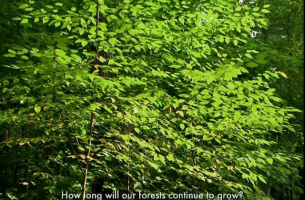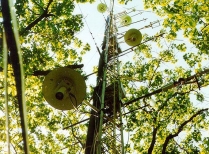You are here
Eddy Flux
![[EMS Tower viewed from Walkup]](/sites/default/files/towerviewedfromwalkup-sm.jpg) Direct measurements of forest-atmosphere exchanges of carbon dioxide, water, energy, and other trace gases allow us to observe whole-ecosystem metabolism as well as quantify the role of forests as sources of trace gases, the input of gaseous pollutants and nutrients, and the role of forests in cleansing the atmosphere. The eddy-covariance flux tower at the Harvard Forest Environmental Measurements Site (HFEMS) was installed in 1989 and provides the world's longest continuous record of net ecosystem CO2 exchange, evaporation, and energy flux between the atmosphere and a forest, at hourly time resolution. Surrounding forest at the EMS tower is mixed hardwood consisting mostly of red oak/red maple mixture and some scattered groves of eastern hemlock. Additional towers in a hemlock stand were installed to examine the differences in carbon flux due to species composition. At both flux-tower sites, the forest is accumulating carbon and contributing to the terrestrial "sink" for carbon that currently is reducing the growth atmospheric CO2. Since 2010 the hemlocks near the flux tower have been infested with hemlock woolly adelgid and are now showing progressive decline in canopy vigor. Having a well instrumented research facility with extended baseline data before the infestation provides a unique opportunity to observe changes in whole ecosystem metabolism as an insect infestation progresses. As of 2018, the CO2 uptake rates have been decreasing, and water yield from the stand has been affected.
Direct measurements of forest-atmosphere exchanges of carbon dioxide, water, energy, and other trace gases allow us to observe whole-ecosystem metabolism as well as quantify the role of forests as sources of trace gases, the input of gaseous pollutants and nutrients, and the role of forests in cleansing the atmosphere. The eddy-covariance flux tower at the Harvard Forest Environmental Measurements Site (HFEMS) was installed in 1989 and provides the world's longest continuous record of net ecosystem CO2 exchange, evaporation, and energy flux between the atmosphere and a forest, at hourly time resolution. Surrounding forest at the EMS tower is mixed hardwood consisting mostly of red oak/red maple mixture and some scattered groves of eastern hemlock. Additional towers in a hemlock stand were installed to examine the differences in carbon flux due to species composition. At both flux-tower sites, the forest is accumulating carbon and contributing to the terrestrial "sink" for carbon that currently is reducing the growth atmospheric CO2. Since 2010 the hemlocks near the flux tower have been infested with hemlock woolly adelgid and are now showing progressive decline in canopy vigor. Having a well instrumented research facility with extended baseline data before the infestation provides a unique opportunity to observe changes in whole ecosystem metabolism as an insect infestation progresses. As of 2018, the CO2 uptake rates have been decreasing, and water yield from the stand has been affected.
The EMS tower has been the site for novel flux studies in addition to the continuous CO2 exchange.![[Sensors on EMS tower]](/sites/default/files/stuffontower-sm.jpg)
- Deployment of fast-response laser spectrometer for measuring direct fluxes of ‑12CO2 and 13CO2 isotopes reveals canopy-scale suppression photo-inhibition of leaf respiration (the Kok effect[).
- Eddy flux measurements of carbonyl sulfide, which is a molecule structurally similar to CO2 that is irreversibly absorbed by leaves under control of carbonic anhydrase (one of the two key enzymes involved in photosynthesis), has been demonstrated as a tracer for stomatal conductance and serves as a proxy for photosynthetic uptake of CO2 under high light conditions when diffusion rather than light controls photosynthesis
The atmospheric carbon fluxes provide a top-down look at forest growth and are complemented by ground measurements of vegetation and litter at large and small plots where we can identify which components in the forest are gaining and losing carbon. The combination of short-term carbon and water exchange fluxes observed at the towers with long-term changes in biomass and species composition observed at permanent plots provides a very powerful constraint to develop and evaluate ecosystem process models.
The Harvard Forest Flux tower cluster is a core site in the
AmeriFlux network and observations made at Harvard Forest can be compared against similar observations throughout the world.
![[Testing sensors]](/sites/default/files/EMS-Tower_2015_mentor-teaching_AM-sm.jpg) Because of its rural location downwind of major east-coast urban areas, but away from nearby pollution sources, the Harvard Forest site is an important observatory for tracking regional air quality. In addition to the carbon flux measurements at HFEMS, we measure carbon monoxide, ozone and nitrogen oxides to quantify potential air pollutant impacts on the forest and assess the role of the forest in removing these pollutants from the atmosphere. Several measurement campaigns have focused on emissions of volatile hydrocarbons such as isoprene from the vegetation. These compounds are an important precursor for atmospheric chemical reactions.
Because of its rural location downwind of major east-coast urban areas, but away from nearby pollution sources, the Harvard Forest site is an important observatory for tracking regional air quality. In addition to the carbon flux measurements at HFEMS, we measure carbon monoxide, ozone and nitrogen oxides to quantify potential air pollutant impacts on the forest and assess the role of the forest in removing these pollutants from the atmosphere. Several measurement campaigns have focused on emissions of volatile hydrocarbons such as isoprene from the vegetation. These compounds are an important precursor for atmospheric chemical reactions.
- Recent analysis of ozone and carbon flux data shows that the mixed deciduous forests represented by the EMS tower have not been impacted by ozone deposition. Domination by oaks, which are not highly sensitive to O3, and the general decline in O3 levels over the past 20 years account for this.
- Analysis of Harvard Forest ozone flux data showed that deposition through the stomata was not the only pathway for ozone fluxes and that interannual variability in ozone flux was influenced by the non-stomatal path. Improved understanding of ozone flux pathways helps to better manage air quality to minimize injury to vegetation.
Key Facilities and Measurement Programs
- 5 eddy flux and walk-up towers.
- Harvard Forest also hosts the NEON Northeast core site
- Various soil-respiration chamber campaigns
- Micrometerological - advection studies
Associated Researchers
Emery Boose
Eric Davidson (WHRC)
Adrien Finzi (BU)
David Fitzjarrald (ASRC)
Mark Friedl (BU)
Lucy Hutyra (BU)
J. William Munger (Harvard SEAS)
Andrew Richardson (Harvard OEB)
Jim Tang (MBL)
Pamela Templer (BU)
Christopher Williams (Clark U.)
Steven Wofsy (Harvard SEAS)



